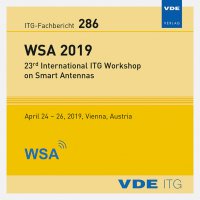Experimental Evaluation of the Influence of Fast Movement on Virtual Antenna Arrays
Conference: WSA 2019 - 23rd International ITG Workshop on Smart Antennas
04/24/2019 - 04/26/2019 at Vienna, Austria
Proceedings: WSA 2019
Pages: 5Language: englishTyp: PDF
Personal VDE Members are entitled to a 10% discount on this title
Authors:
Schuetzenhoefer, Daniel; Pratschner, Stefan (Christian Doppler Laboratory for Dependable Wireless Connectivity for the Society in Motion & Institute of Telecommunications, TU Wien, Austria)
Zoechmann, Erich (Christian Doppler Laboratory for Dependable Wireless Connectivity for the Society in Motion & Institute of Telecommunications, TU Wien, Austria & Department of Radio Electronics, TU Brno, Czech Republic)
Lerch, Martin; Groll, Herbert; Caban, Sebastian; Rupp, Markus (Institute of Telecommunications, TU Wien, Austria)
Abstract:
Virtual antenna arrays are employed on the roof of high-speed trains to sound the channel between a train and a fixed base station. Because high-speed trains are moving fast during such a measurement, high Doppler shifts are experienced. In this paper, we evaluate the influence of fast movement on measurements with virtual antenna arrays if algorithms for static scenarios are employed. We have built a laboratory setup to test common algorithms such as the Bartlett beamformer. Our laboratory setup allows to compare the performance of algorithms at standstill to the performance of the same algorithms at different velocities. We show that the estimated power angular spectrum changes up to 20 dB in magnitude if we apply the same algorithm as in the static scenario. The Doppler effect also causes an angular shift. We experience that the difference in circular variance is 7.4 %. The measurement results show that DOA estimation algorithms that do not consider Doppler are not consistent anymore at fast movement.


